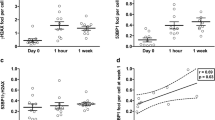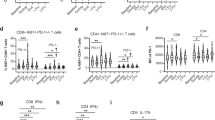Abstract
The purpose of our study was to assess the immune function of patients with inoperable hepatic malignancies after treatment with selective internal radiotherapy (SIRT) and to identify possible correlations with clinical parameters. In 25 patients receiving SIRT lymphocyte proliferation and the production of pro- and anti-inflammatory cytokines (interferon-γ and interleukin-10) after stimulation with mitogens and microbial antigens were tested prior to therapy, directly after therapy (day 1) and at day 2, 7 and 28 post therapy using the lymphocyte transformation test and enzyme-linked immunospot assays. Absolute counts and percentages of leukocyte and lymphocyte subsets were determined by flow cytometry. The most prominent finding was an immediate and significant (p < 0.05) decrease of lymphocyte proliferation and interferon-γ production directly after therapy which lasted until day 28 and was stronger upon stimulation with microbial antigens than with mitogens. Moreover, lymphopenia was revealed, affecting all lymphocyte subsets (CD3+, CD4+, CD8+ T cells, CD4+ CD8+ T cells, B cells and NK cells). SIRT led to a reduction in the percentage of activated HLA-DR+ monocytes and of CD45R0+ memory T cells. Higher radiation activity, the presence of liver cirrhosis, chronic kidney disease, diabetes mellitus and metastases were unfavorable factors for immunocompetence, while a better Eastern Cooperative Oncology Group performance status was associated with stronger immunological reactions. In conclusion, SIRT leads to severe impairment of cellular in vitro immune responses. Further studies are needed to assess a potential clinical impact.


Similar content being viewed by others
Abbreviations
- CAN:
-
Candida albicans
- Cpm:
-
Counts per minute
- DOTATOC:
-
DOTA(0)-Phe(1)-Tyr(3)-octreotide
- ECOG:
-
Eastern Cooperative Oncology Group
- HCC:
-
Hepatocellular carcinoma
- HSV-1:
-
Herpes simplex virus type 1
- LTT:
-
Lymphocyte transformation test
- OKT3:
-
Anti-CD3 monoclonal antibody
- PPD:
-
Purified protein derivate
- PWM:
-
Pokeweed mitogen
- SIRT:
-
Selective internal radiotherapy
- TET:
-
Tetanus toxoid
- 90Y:
-
Yttrium-90
References
Lewandowski RJ, Salem R (2006) Yttrium-90 radioembolization of hepatocellular carcinoma and metastatic disease to the liver. Semin Interv Radiol 23:64–72. https://doi.org/10.1055/s-2006-939842
Wang LM, Jani AR, Hill EJ, Sharma RA (2013) Anatomical basis and histopathological changes resulting from selective internal radiotherapy for liver metastases. J Clin Pathol. 66:205–211. https://doi.org/10.1136/jclinpath-2012-201231
Breedis C, Young G (1954) The blood supply of neoplasms in the liver. Am J Pathol. 30:969–985
Barsegian V, Müller SP, Horn PA, Bockisch A, Lindemann M (2011) Lymphocyte function following radioiodine therapy in patients with thyroid carcinoma. Nuklearmedizin 50:195–203. https://doi.org/10.3413/nukmed-04241108
Barsegian V, Hueben C, Mueller SP, Poeppel TD, Horn PA, Bockisch A, Lindemann M (2015) Impairment of lymphocyte function following yttrium-90 DOTATOC therapy. Cancer Immunol Immunother. 64:755–764. https://doi.org/10.1007/s00262-015-1687-3
Sierra ML, Agazzi A, Bodei L et al (2009) Lymphocytic toxicity in patients after peptide-receptor radionuclide therapy (PRRT) with 177 lu-DOTATATE and 90Y-DOTATOC. Cancer Biother Radiopharm 24:659–665. https://doi.org/10.1089/cbr.2009.0641
Greenway CV, Stark RD (1971) Hepatic vascular bed. Physiol Rev 51:23–65
Schenk WG Jr, Mc DJ, Mc DK, Drapanas T (1962) Direct measurement of hepatic blood flow in surgical patients: with related observations on hepatic flow dynamics in experimental animals. Ann Surg. 156:463–471
Yzet T, Bouzerar R, Baledent O, Renard C, Lumbala DM, Nguyen-Khac E, Regimbeau J-M, Deramond H, Meyer M-E (2010) Dynamic measurements of total hepatic blood flow with Phase Contrast MRI. Eur J Radiol. 73:119–124. https://doi.org/10.1016/j.ejrad.2008.09.032
Parker GA, Picut CA (2012) Immune functioning in non lymphoid organs: the liver. Toxicol Pathol. 40:237–247. https://doi.org/10.1177/0192623311428475
Nemeth E, Baird AW, O’Farrelly C (2009) Microanatomy of the liver immune system. Semin Immunopathol 31:333–343. https://doi.org/10.1007/s00281-009-0173-4
Norris S, Collins C, Doherty DG, Smith F, McEntee G, Traynor O, Nolan N, Hegarty J, O’Farrelly C (1998) Resident human hepatitis lymphocytes are phenotypically different from circulating lymphocytes. J Hepatol 28:84–90. https://doi.org/10.1016/s0168-8278(98)80206-7
Pruvot FRNF, Janin A, Labalette M, Masy E, Lecomte-HouckeM et al (1995) Characterization, quantification, and localization of passenger T lymphocytes and NK cells in human liver before transplantation. Transpl Int 8:273–279
Doherty DG, O’Farrelly C (2000) Innate and adaptive lymphoid cells in the human liver. Immunol Rev 174:5–20
Xu XD, Ueta H, Zhou S, Shi C, Koga D, Ushiki T, Matsuno K (2008) Trafficking of recirculating lymphocytes in the rat liver: rapid transmigration into the portal area and then to the hepatic lymph. Liver Int 28:319–330. https://doi.org/10.1111/j.1478-3231.2008.01671.x
Tu Z, Bozorgzadeh A, Crispe IN, Orloff MS (2007) The activation state of human intrahepatic lymphocytes. Clin Exp Immunol. 149:186–93. https://doi.org/10.1111/j.1365-2249.2007.03415.x
Ohtani O, Ohtani Y (2008) Lymph circulation in the liver. Anat Rec (Hoboken) 291:643–52. https://doi.org/10.1002/ar.20681
Mouta Carreira C, Nasser SM, di Tomaso E, Padera TP, Boucher Y, Tomarev SI, Jain RK (2001) LYVE-1 is not restricted to the lymph vessels: expression in normal liver blood sinusoids and down-regulation in human liver cancer and cirrhosis. Cancer Res 61:8079–8084
Carr BI (2004) Hepatic arterial 90Yttrium glass microspheres (Therasphere) for unresectable hepatocellular carcinoma: Interim safety and survival data on 65 patients. Liver Transpl 10:S107-S110. https://doi.org/10.1002/lt.20036
Salem R, Lewandowski RJ, Atassi B, Gordon SC, Gates VL, Barakat O, Sergie Z, Wong CY, Thurston KG (2005) Treatment of unresectable hepatocellular carcinoma with use of 90Y microspheres (TheraSphere): safety, tumor response, and survival. J Vasc Interv Radiol 16:1627–1639. https://doi.org/10.1097/01.rvi.0000184594.01661.81
Carr BI, Metes DM (2012) Peripheral blood lymphocyte depletion after hepatic arterial 90Yttrium microsphere therapy for hepatocellular carcinoma. Int J Radiat Oncol Biol Phys 82:1179–1184. https://doi.org/10.1016/j.ijrobp.2010.10.042
Czerkinsky C, Andersson G, Ekre HP, Nilsson LA, Klareskog L, Ouchterlony O (1988) Reverse ELISPOT assay for clonal analysis of cytokine production. I. Enumeration of gamma-interferon-secreting cells. J Immunol Methods 110:29–36
Lindemann M, Witzke O, Winterhagen T et al (2004) T-cell function after interleukin-2 therapy in HIV-infected patients is correlated with serum cortisol concentrations. AIDS 18:2001–2007
Robinson MW, Harmon C, O’Farrelly C (2016) Liver immunology and its role in inflammation and homeostasis. Cell Mol Immunol. 13:267–276. https://doi.org/10.1038/cmi.2016.3
Crispe IN (2009) The liver as a lymphoid organ. Annu Rev Immunol. 27:147–163. https://doi.org/10.1146/annurev.immunol.021908.132629
Shi J, Gilbert GE, Kokubo Y, Ohashi T (2001) Role of the liver in regulating numbers of circulating neutrophils. Blood 98:1226–1230
Fernandez-Ros N, Inarrairaegui M, Paramo JA et al (2015) Radioembolization of hepatocellular carcinoma activates liver regeneration, induces inflammation and endothelial stress and activates coagulation. Liver Int 35:1590–1596. https://doi.org/10.1111/liv.12592
Marshall LJ, Ramdin LS, Brooks T, PC DP, Shute JK (2003) Plasminogen activator inhibitor-1 supports IL-8-mediated neutrophil transendothelial migration by inhibition of the constitutive shedding of endothelial IL-8/heparan sulfate/syndecan-1 complexes. J Immunol 171:2057–2065
Mackay CR, Marston WL, Dudler L (1990) Naive and memory T cells show distinct pathways of lymphocyte recirculation. J Exp Med. 171:801–817
Fu H, Ward EJ, Marelli-Berg FM (2016) Mechanisms of T cell organotropism. Cell Mol Life Sci 73:3009–3033. https://doi.org/10.1007/s00018-016-2211-4
Lalor PF, Shields P, Grant AJ, Adams DH (2002) Recruitment of lymphocytes to the human liver. Immunol Cell Biol 80:52–64
Grayson JM, Harrington LE, Lanier JG, Wherry EJ, Ahmed R (2002) Differential sensitivity of naive and memory CD8+ T cells to apoptosis in vivo. J Immunol 169:3760–3770. https://doi.org/10.4049/jimmunol.169.7.3760
Oo YH, Adams DH (2010) The role of chemokines in the recruitment of lymphocytes to the liver. J Autoimmun 34:45–54. https://doi.org/10.1016/j.jaut.2009.07.011
Cao MD, Chen ZD, Xing Y (2004) Gamma irradiation of human dendritic cells influences proliferation and cytokine profile of T cells in autologous mixed lymphocyte reaction. Cell Biol Int 28:223–228. https://doi.org/10.1016/j.cellbi.2003.12.006
Ashwell MKJaRHS JD (1988) Effect of gamma radiation on resting B lymphocytes. II. Functional characterization of the antigen-presentation defect. J Immunol 141:2536–2544;
Nakayama Y, Makino S, Fukuda Y, Min KY, Ikemoto T, Shimizu A, Ohsawa N (1995) Varied effects of thoracic irradiation on peripheral lymphocyte subsets in lung cancer patients. Intern Med. 34:959–965
Acknowledgements
This article is a partial fulfillment of requirements for the doctor’s degree at the Medical Faculty, University of Duisburg-Essen, for Mrs. A. Domouchtsidou. We thank M. Huben, B. Nyadu and M. Praast for their excellent technical assistance.
Funding
No relevant funding.
Author information
Authors and Affiliations
Contributions
AD, VB, SPM, AB and ML contributed to the conception and design of the study. AD, PAH and ML wrote the report. AD, JB, JE and SB recruited the patients and took blood samples. AD performed the cellular in vitro assays. All authors read and approved the final manuscript.
Corresponding author
Ethics declarations
Conflict of interest
The authors declare that they have no conflict of interest.
Ethical approval and ethical standards
The study was institutional review board approved by the ethics committee of the Medical Faculty, University Hospital Essen (approval number 09-3991), and carried out in accordance with the 1964 Helsinki Declaration.
Informed consent
All patients provided written informed consent prior to their inclusion in the study.
Rights and permissions
About this article
Cite this article
Domouchtsidou, A., Barsegian, V., Mueller, S.P. et al. Impaired lymphocyte function in patients with hepatic malignancies after selective internal radiotherapy. Cancer Immunol Immunother 67, 843–853 (2018). https://doi.org/10.1007/s00262-018-2141-0
Received:
Accepted:
Published:
Issue Date:
DOI: https://doi.org/10.1007/s00262-018-2141-0




